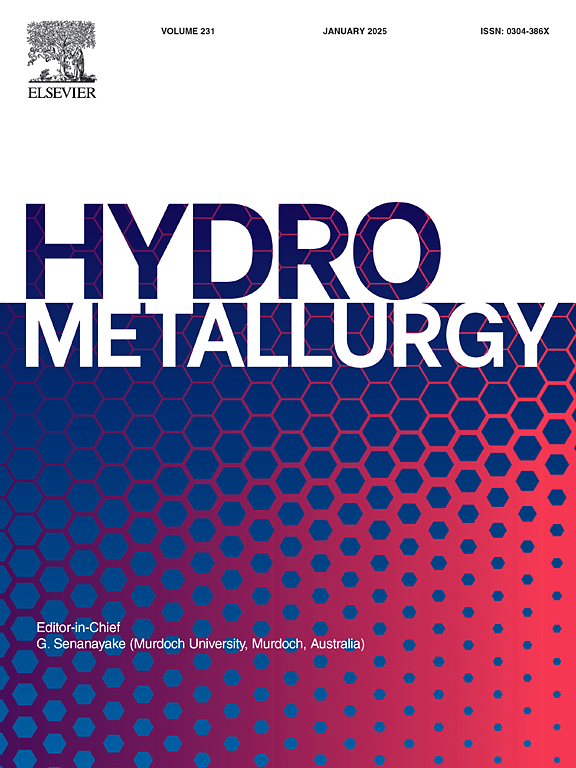电沉积铜的缩放分析以及改性多糖对表面粗糙度的影响
IF 4.8
2区 材料科学
Q1 METALLURGY & METALLURGICAL ENGINEERING
引用次数: 0
摘要
采用原子力显微镜 (AFM)、线性扫描轮廓仪和缩放分析法研究了市售改性多糖(HydroStar®,Chemstar 化学制品公司)对短期和小规模铜电沉积粗糙度的影响。铜沉积在 316L 不锈钢阴极上,温度为 40 °C,电流为 300 A m-2,电解液中含有 40 g L-1 Cu2+、170 g L-1 H2SO4、1.5 g L-1 Fe3+、15 mg L-1 Cl- 和 0、10、50 或 100 mg L-1 的 HydroStar。使用原子力显微镜对 15 至 25 分钟内产生的铜沉积物进行成像,并使用二维线性扫描轮廓仪收集 120 至 240 分钟内产生的铜样品的表面特征。缩放分析用于量化极限粗糙度(δ)和临界长度(LC)的表面特征,由此计算出δ/LC,并将其与表面特征的纵横比联系起来。随着沉积时间的延长,所有铜沉积物的 δ 和 LC 都普遍升高,但当电解液中加入 HydroStar 时,铜沉积物的生长率降低,这表明添加剂降低了表面特征的垂直高度和宽度。此外,在有 HydroStar 的情况下,铜沉积物的生成更加稳定,而且在给定的极限粗糙度值下,铜沉积物的表面特征比没有添加剂时更宽。结果表明,改性多糖通过产生较低纵横比的表面特征来形成光滑的铜沉积物。本文章由计算机程序翻译,如有差异,请以英文原文为准。
Scaling analysis of electrodeposited copper and the influence of a modified polysaccharide on surface roughness
The influence of a commercially available modified polysaccharide (HydroStar®, Chemstar Chemical Products) on the roughness of short-term and small-scale copper electrodeposits was investigated using Atomic Force Microscopy (AFM), linear scan profilometry and scaling analysis. Copper was deposited on a 316L stainless steel cathode at 40 °C and 300 A m−2 from an electrolyte containing 40 g L−1 Cu2+, 170 g L−1 H2SO4, 1.5 g L−1 Fe3+, 15 mg L−1 Cl− and either 0, 10, 50 or 100 mg L−1 of HydroStar. Copper deposits produced between 15 and 25 min were imaged using AFM and 2D linear scan profilometry was used to gather surface features of copper samples produced in the range of 120 and 240 min. Scaling analysis was applied to quantify the surface characteristics of limiting roughness (δ) and critical length (LC) from which δ/LC was computed and related to the aspect ratio of surface features. All copper deposits showed a general rise in δ and LC with deposition time but the growth rates decreased when HydroStar was included in the electrolyte indicating that the additive lowers the vertical height of surface features as well as their widths. Furthermore, copper deposits were more consistently produced in the presence of HydroStar and, for a given value of limiting roughness, had surface features with wider base than those created in the absence of the additive. The results show that the modified polysaccharide acts to create smooth copper deposits by generating surface features with lower aspect ratios.
求助全文
通过发布文献求助,成功后即可免费获取论文全文。
去求助
来源期刊

Hydrometallurgy
工程技术-冶金工程
CiteScore
9.50
自引率
6.40%
发文量
144
审稿时长
3.4 months
期刊介绍:
Hydrometallurgy aims to compile studies on novel processes, process design, chemistry, modelling, control, economics and interfaces between unit operations, and to provide a forum for discussions on case histories and operational difficulties.
Topics covered include: leaching of metal values by chemical reagents or bacterial action at ambient or elevated pressures and temperatures; separation of solids from leach liquors; removal of impurities and recovery of metal values by precipitation, ion exchange, solvent extraction, gaseous reduction, cementation, electro-winning and electro-refining; pre-treatment of ores by roasting or chemical treatments such as halogenation or reduction; recycling of reagents and treatment of effluents.
 求助内容:
求助内容: 应助结果提醒方式:
应助结果提醒方式:


